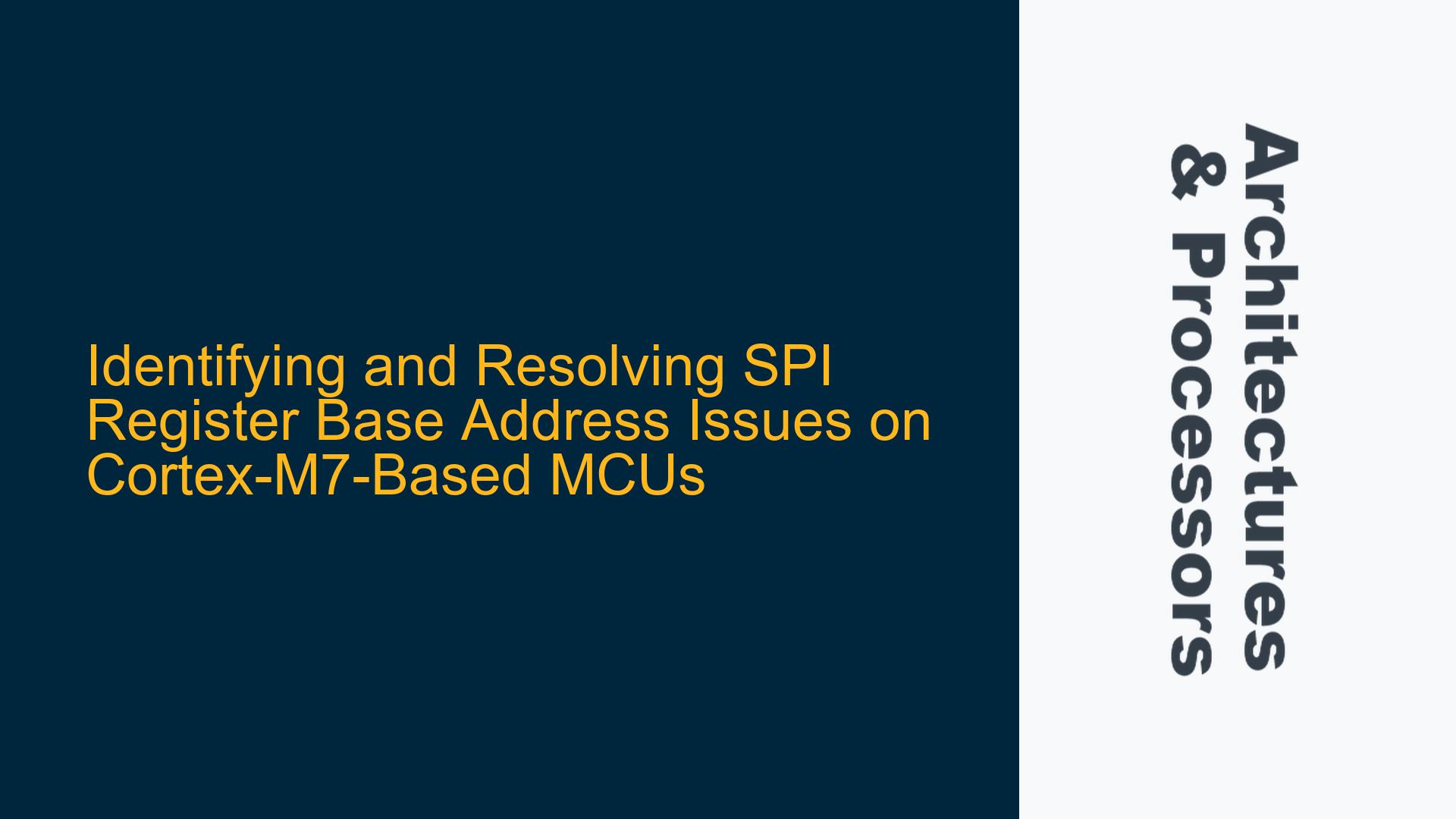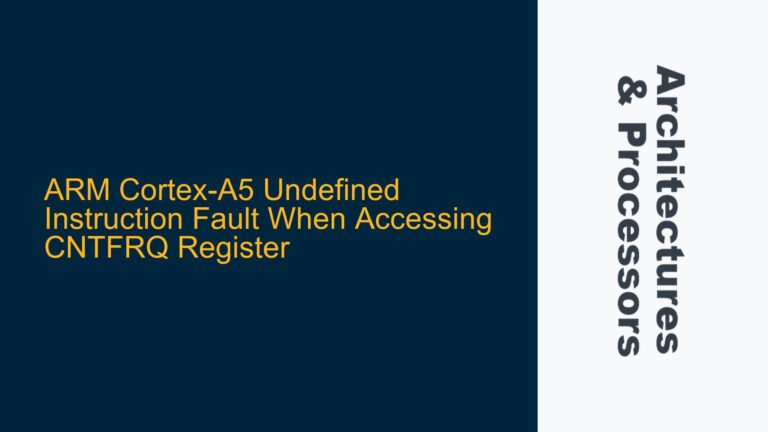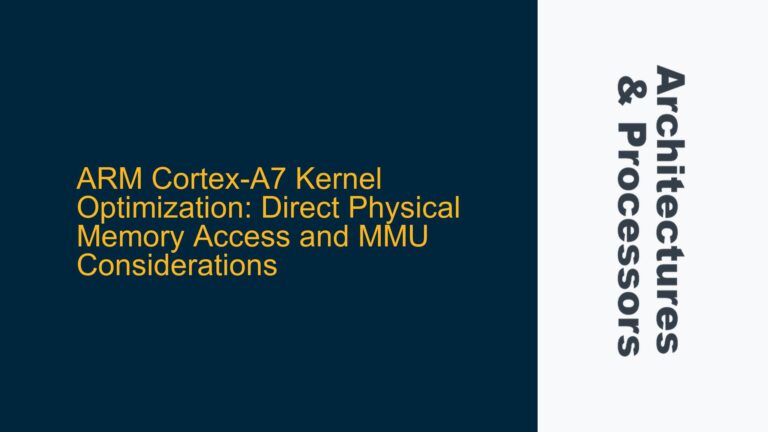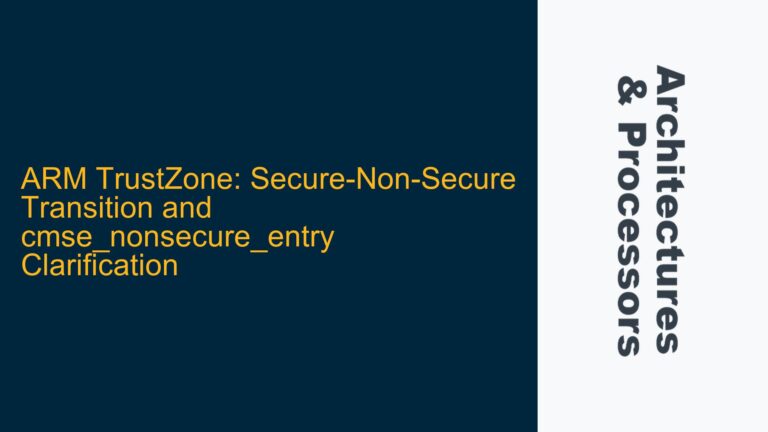Cortex-M7 SPI Peripheral Register Base Address Confusion
The Cortex-M7 is a high-performance microcontroller core designed by ARM, widely used in embedded systems for its advanced features such as a dual-issue pipeline, floating-point unit, and cache memory. However, one common source of confusion among developers working with Cortex-M7-based microcontrollers, such as the NXP i.MX RT1060 used in the Teensy 4.0 board, is determining the base address of peripheral registers, particularly for interfaces like SPI (Serial Peripheral Interface). This issue arises due to the distinction between the ARM Cortex-M7 core and the microcontroller unit (MCU) that integrates the core with peripherals. The ARM Cortex-M7 documentation does not specify peripheral register base addresses because these are defined by the MCU manufacturer, not ARM. This guide will provide a detailed explanation of the problem, its root causes, and step-by-step solutions to resolve it.
Misalignment Between ARM Core Documentation and MCU-Specific Implementations
The confusion often stems from a misunderstanding of the relationship between the ARM Cortex-M7 core and the MCU that incorporates it. The ARM Cortex-M7 core is a processor core that executes instructions and manages memory, but it does not include peripherals such as SPI, I2C, or UART. These peripherals are added by the MCU manufacturer, such as NXP, STMicroelectronics, or others, and their register addresses are defined in the MCU’s reference manual, not in the ARM documentation. For example, the RM0444 Reference Manual mentioned in the discussion is specific to STMicroelectronics’ STM32 microcontrollers and does not apply to the NXP i.MX RT1060 used in the Teensy 4.0.
This misalignment can lead developers to search for peripheral register base addresses in the wrong documentation. The ARM Cortex-M7 Technical Reference Manual (TRM) provides details about the core’s architecture, including its instruction set, memory model, and core peripherals like the Nested Vectored Interrupt Controller (NVIC) and System Control Block (SCB). However, it does not cover MCU-specific peripherals like SPI. Developers must consult the MCU manufacturer’s documentation to find the correct base addresses for these peripherals.
For the NXP i.MX RT1060, the SPI peripheral registers are documented in the i.MX RT1060 Reference Manual. Each SPI instance (e.g., SPI1, SPI2) has a unique base address, which is typically defined in the MCU’s memory map. These addresses are also provided in the MCU’s header files, which are part of the software development kit (SDK) provided by the manufacturer. For example, the base address for SPI1 on the i.MX RT1060 might be defined as 0x40394000 in the SDK’s header files.
Locating and Verifying SPI Register Base Addresses in MCU Documentation
To resolve the issue of finding the correct SPI register base address, developers must follow a systematic approach to locate and verify the information in the appropriate documentation. The first step is to identify the specific MCU being used and obtain its reference manual from the manufacturer’s website. For the Teensy 4.0, this means consulting the NXP i.MX RT1060 Reference Manual.
In the reference manual, the memory map section provides a detailed overview of the address ranges assigned to different peripherals. The SPI peripheral registers will be listed under a specific memory range, and each SPI instance (e.g., SPI1, SPI2) will have its own base address. For example, the i.MX RT1060 Reference Manual might specify that SPI1 is located at 0x40394000, SPI2 at 0x40398000, and so on. These addresses are fixed and defined by the hardware design of the MCU.
Once the base address is identified, developers should cross-reference it with the SDK header files provided by the MCU manufacturer. These header files typically define symbolic constants for the base addresses of all peripherals, making it easier to use them in code. For example, the NXP SDK for the i.MX RT1060 might include a header file named fsl_spi.h that defines SPI1_BASE as 0x40394000.
To verify the correctness of the base address, developers can write a simple program to read and write to the SPI registers. For example, writing a known value to the SPI control register and then reading it back can confirm that the correct base address is being used. If the read value matches the written value, the base address is correct. If not, further investigation is needed to ensure that the correct documentation and header files are being used.
Implementing SPI Communication Using the Correct Base Address
Once the correct SPI register base address has been identified and verified, developers can proceed to implement SPI communication in their firmware. This involves configuring the SPI peripheral by setting the appropriate values in its control registers, such as the baud rate, data frame format, and clock polarity. The specific steps for configuring the SPI peripheral will depend on the MCU and the requirements of the application.
For example, to configure SPI1 on the i.MX RT1060, developers would first enable the clock for the SPI peripheral by setting the appropriate bit in the Clock Gating Control Register (CCGR). Next, they would configure the SPI control registers, such as the SPI Control Register 1 (SPIx_CR1), to set the desired communication parameters. This might include setting the baud rate divisor, selecting the data frame size (e.g., 8-bit or 16-bit), and configuring the clock polarity and phase.
After configuring the SPI peripheral, developers can initiate data transfers by writing to the SPI Data Register (SPIx_DR). The SPI peripheral will automatically handle the serialization and deserialization of data, as well as the generation of the clock signal. Developers can monitor the status of the SPI transfer by reading the SPI Status Register (SPIx_SR), which provides information such as whether the transmit buffer is empty or the receive buffer is full.
To ensure reliable communication, developers should also implement error handling and recovery mechanisms. For example, if a SPI transfer fails due to a bus error or a timeout, the firmware should reset the SPI peripheral and retry the transfer. Additionally, developers should consider using DMA (Direct Memory Access) to offload the CPU from managing SPI data transfers, especially in high-bandwidth applications.
In conclusion, the issue of determining the SPI register base address on Cortex-M7-based MCUs like the NXP i.MX RT1060 stems from a misunderstanding of the distinction between the ARM Cortex-M7 core and the MCU that integrates it. By consulting the correct MCU-specific documentation and verifying the base address through code, developers can resolve this issue and successfully implement SPI communication in their applications. This systematic approach ensures that the firmware is both correct and efficient, leveraging the full capabilities of the Cortex-M7 core and the MCU’s peripherals.






